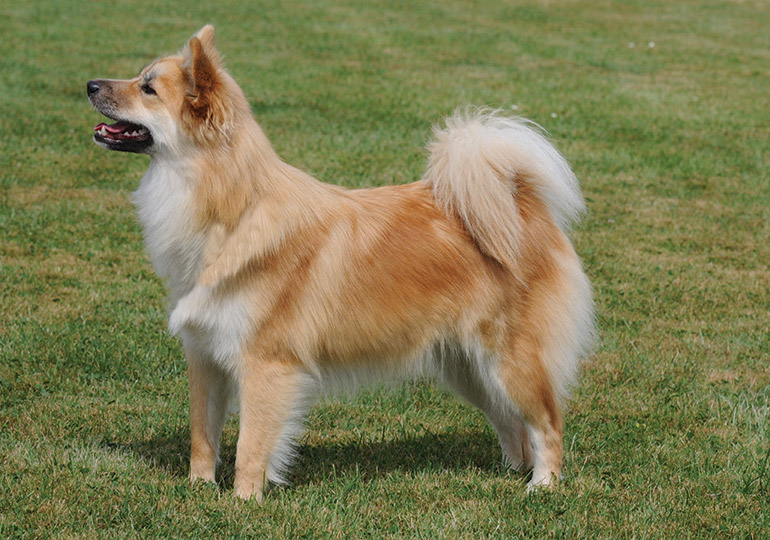Icelandic Sheepdog
Breed Details
Size:
Exercise Requirements:
Grooming Requirements:
11-14 Kg (Approx)
12-14 years (Approx)

Appearance
The Icelandic Sheepdog is a Nordic herding Spitz, slightly under medium sized with prick ears and a curled tail. Seen from the side the dog is rectangular; the length of the body from the point of shoulder to point of buttock is greater than the height at withers. The depth of the chest is equal to the length of the foreleg. The expression is gentle, intelligent and happy. A confident and lively bearing is typical for this dog. There are two types of coat, long and short both thick and extremely weatherproof. There is a marked difference in appearance between the sexes.
History
The Icelandic Sheepdog is Iceland’s only native dog. It was brought to Iceland with the first Viking settlers (AD 874 - 930). The Icelandic Sheepdog and its method of working adapted to the local terrain, farming methods and the hard struggle for survival of the Icelandic people over the centuries, making it indispensable in the rounding up of livestock on the farms. The Icelandic sheepdog’s popularity has increased over the last few decades and, despite the fact the breed is still very small in numbers, it is no longer considered to be in danger of extinction.
Temperament
The Icelandic Sheepdog is a hardy and agile herding dog which barks, making it extremely useful for herding or driving livestock in the pastures, in the mountains or finding stray sheep. The Icelandic Sheepdog is by nature very alert and will always give visitors an enthusiastic welcome without being aggressive. Hunting instincts are not strong.
The Icelandic Sheepdog is cheerful, friendly, inquisitive, playful and unafraid.
When herding, the Icelandic Sheepdogs were not mainly used to take the sheep from one point to another, but to prevent animals from straying. Additionally, the dogs were in charge of herding horses and other animals, as well. When herding failed, the dogs drove the animals by barking. Thus, they tend to bark when they want something, although this behaviour can be controlled by training.
In the Icelandic landscape, sheep often get lost and it has historically been the dog's job to find them and return them to the herd. They are, therefore, used to working on their own and to figuring things out for themselves, so owners have to beware lest they learn things they should not. As a watch dog, their main task was to alert the inhabitants when somebody was coming, so these dogs tend to bark a lot when they see people approaching.
The Icelandic Sheepdog is very loyal and wants to be around its family constantly. It follows its owner everywhere. Unlike most working dogs, these calm down when indoors and happily lie down at their master's feet.
Care/Grooming
The Icelandic Sheepdog has a profuse double coat, with a longer outer coat and a dense undercoat. Icelandic Sheepdogs shed a fair amount, even more so during shedding season, which occurs twice a year. Regular brushing is recommended.
Breeders
Currently no Breeders in SA for this Breed

